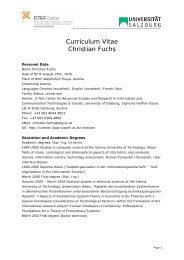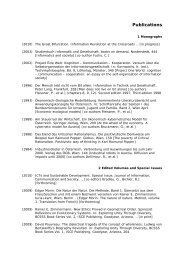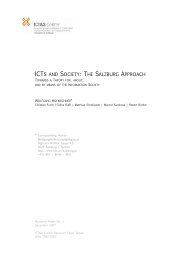CHRISTIAN FUCHS - ICT&S - Universität Salzburg
CHRISTIAN FUCHS - ICT&S - Universität Salzburg
CHRISTIAN FUCHS - ICT&S - Universität Salzburg
Create successful ePaper yourself
Turn your PDF publications into a flip-book with our unique Google optimized e-Paper software.
Christian Fuchs: Social Networking Sites and the Surveillance SocietySonia Livingstone (2008) conducted qualitative interviews with ISNS users (N=16, agebetween 13 and 16) and found out that younger teenagers prefer identity managementand aesthetic concerns on their profiles, whereas older teenagers find their personallinks more important. Teenagers would not be unconcerned about their privacy onISNS. “The point is that teenagers must and do disclose personal information in order tosustain intimacy, but they wish to be in control of how they manage this disclosure”(Livingstone 2008: 405). They typically want to have their profile public for friends andprivate to persons. They, according to Livingstone, distinguish between different degreesof closeness to their friends on SNS and find it frustrating that most ISNS do not allowdiscriminating levels of access to personal information within the list of friends.“Unsurprisingly, then, when asked whether they would like to change anythingabout social networking, the operation of privacy settings and provision of privatemessaging on the sites are teenagers’ top priorities, along with elimination ofspam and chain messages – both intrusions of their privacy” (Livingstone 2008:406).Raacke and Bonds-Raacke (2008) conducted a study that showed that the majority ofcollege students use ISNS for making new friends, locating old friends, and staying intouch with existing friends.Thelwall (2008) in two waves analyzed 15043 and 7627 MySpace profiles. He foundthat the median number of friends of people who have at least two friends is 27 andthat the median age is 21.Zhao, Grasmuck and Martin (2008) analyzed 63 Facebook profiles and conclude thatidentity is shown and not told by stressing group belonging and personal identities overpersonal narratives.3.3. Critical Research about Integrated Social Networking SitesBased on a synthesis of definitions (Gandy 1982: 2, Hardt 1992: x, Kellner 1995: 4,Kellner/Durham 2006: xiv, Knoche 2005: 105, Winter 2004: 118-120), critical mediaand communication theory and research can be defined as studies that focusontologically on the analysis of media, communication, and culture in the context ofdomination, asymmetrical power relations, exploitation, oppression, and control byemploying epistemologically all theoretical and/or empirical means necessary in orderto contribute at the praxeological level to the establishment of a participatory, cooperativesociety. This definition is fairly broad and allows to combine differentconcepts that come from different critical backgrounds, such as for example – to namejust some of many – audience commodity, media accumulation strategies, commodityaesthetics, culture industry, true and false consciousness/needs, instrumental reason,technological rationality, manipulation, ideology critique, dialectical theatre, criticalpedagogy, aura, proletarian counter-public sphere, multiple publics, emancipatorymedia usage, repressive media usage, alternative media, radical media, fetish ofcommunication, ideological state apparatuses, the multitude, the circulation ofstruggles, hegemony, structure of feelings, articulation, dominant reading, oppositionalreading, negotiated reading, capital-accumulation function of the media, commodity20









